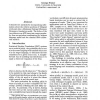1302 search results - page 82 / 261 » Fair Equivalence Relations |
LACL
2001
Springer
14 years 2 months ago
2001
Springer
Lambek [13] introduces pregroups as a new framework for syntactic structure. In this paper we prove some new theorems on pregroups and study grammars based on the calculus of free...
EUSFLAT
2007
13 years 11 months ago
2007
This paper deals with interval-valued fuzzy sets and I-fuzzy sets, Atanassov's intuitionistic fuzzy sets. They are treated in a systematic way as two, formally equivalent, na...
ACL
2000
13 years 11 months ago
2000
I describe two methods for incorporating information about the relative positions of bilingual word pairs into a Maximum Entropy/Minimum Divergence translation model. The better o...
DAM
2006
13 years 10 months ago
2006
We investigate the relation between two aspects of round robin tournament scheduling problems: breaks and distances. The distance minimization problem and the breaks maximization ...
JAIR
2008
13 years 10 months ago
2008
The notion of strong equivalence on logic programs with answer set semantics gives rise to a consequence relation on logic program rules, called SE-consequence. We present a sound...

